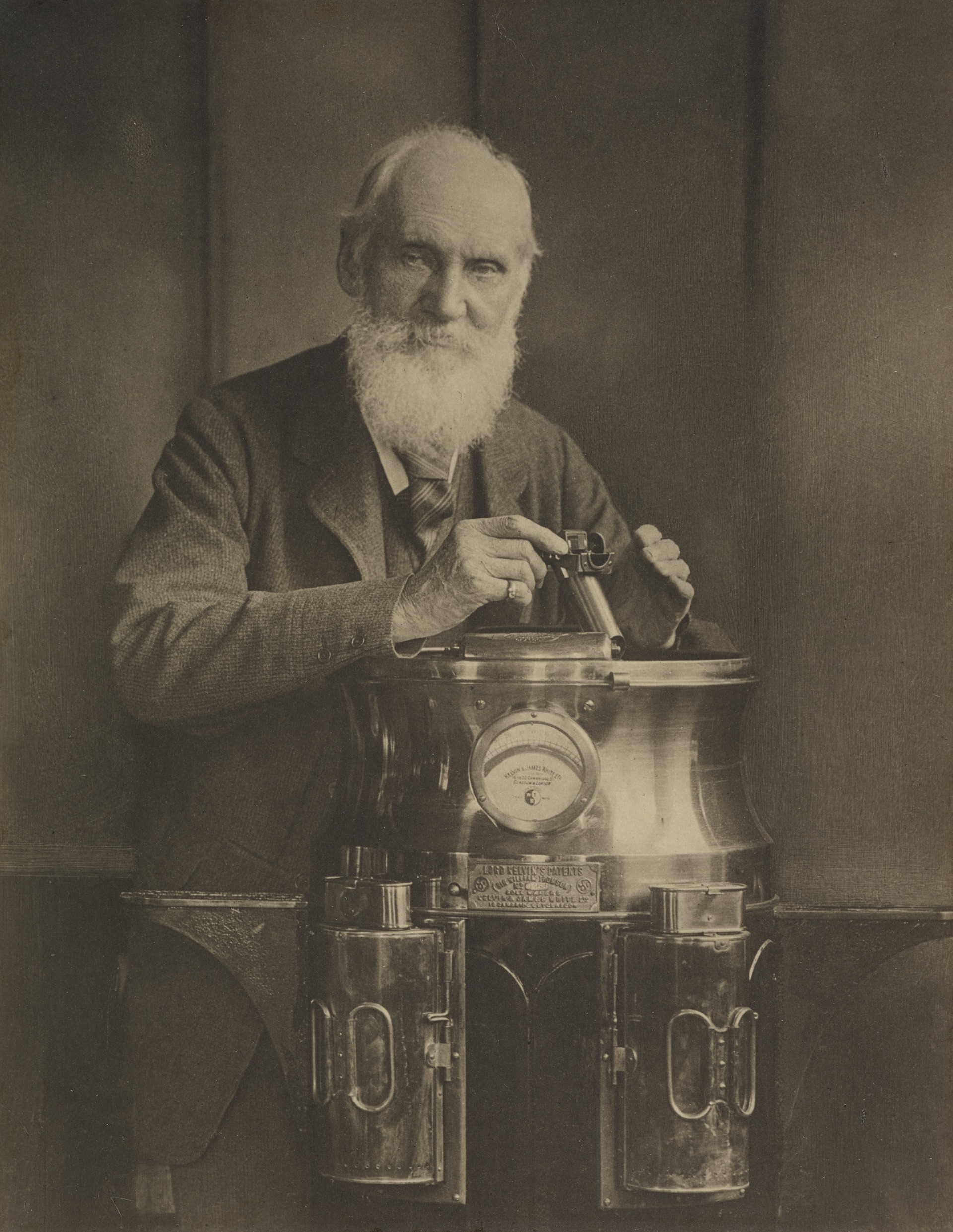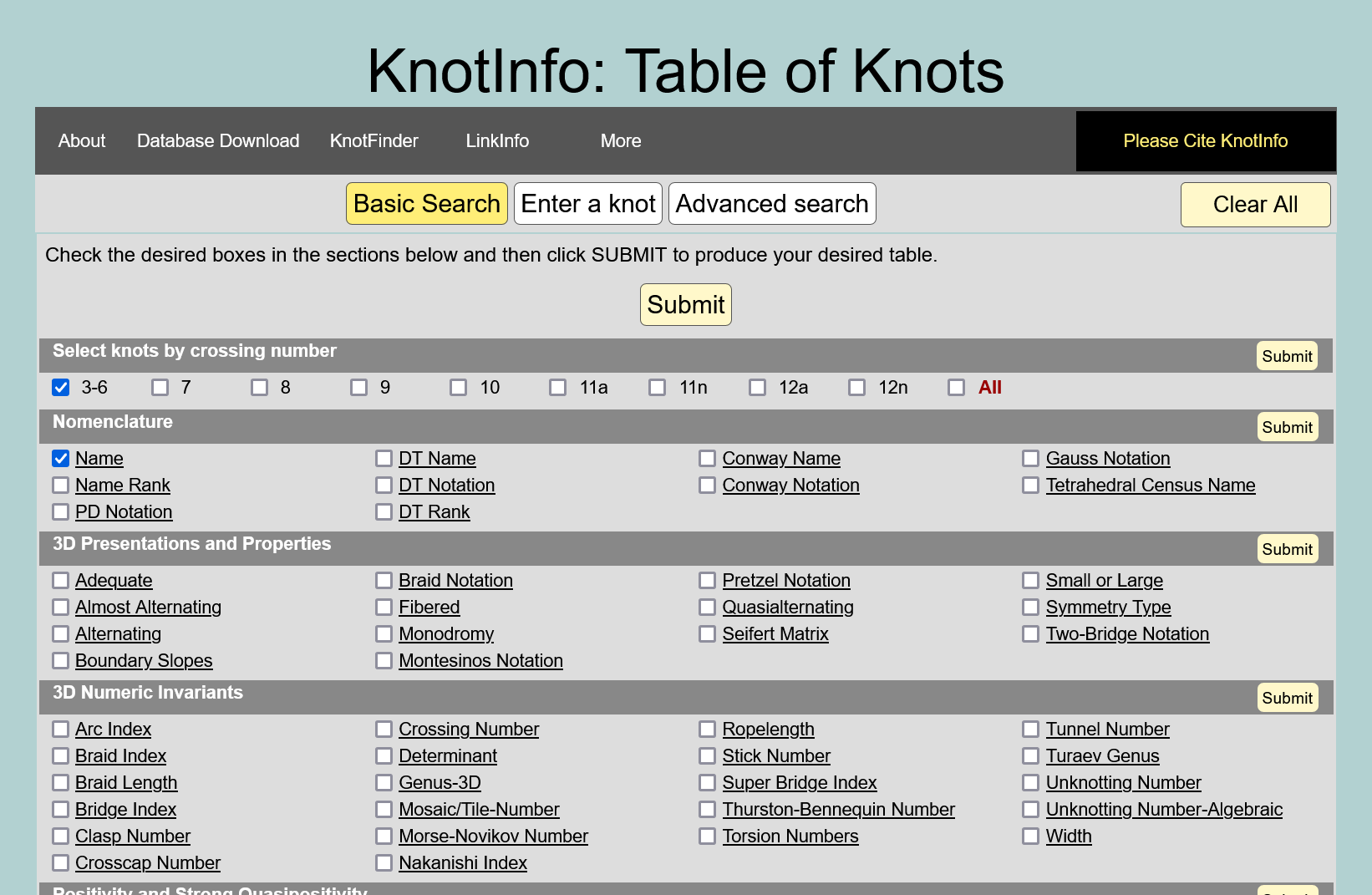$\newcommand{\N}{\mathbb{N}} \newcommand{\Z}{\mathbb{Z}} \newcommand{\Q}{\mathbb{Q}} \newcommand{\R}{\mathbb{R}} \newcommand{\LP}{\left(} \newcommand{\RP}{\right)} \newcommand{\LS}{\left\lbrace} \newcommand{\RS}{\right\rbrace} \newcommand{\LA}{\left\langle} \newcommand{\RA}{\right\rangle} \newcommand{\LB}{\left[} \newcommand{\RB}{\right]} \newcommand{\MM}{\ \middle|\ } \newcommand{\exp}{\text{exp}} \newcommand{\abs}[1]{\left\vert#1\right\vert} \newcommand{\msr}[1]{m\left(#1\right)} \newcommand{\inv}[1]{#1^{-1}} \newcommand{\bkt}[1]{\LA \img{#1}\RA} \require{color}$
The Tanglenomicon
Zachary Bryhtan, Nicholas Connolly, Isabel Darcy, Ethan Rooke, Joseph Starr*
Mathematics Department at The University of Iowa
Knots
“A knot is a smooth embedding of a circle $S^1$ into Euclidean 3-dimensional space $\R^3$ (or the 3-dimensional sphere $S^3$ ).”
Jablan, S., & Sazdanović, R. (2007). Linknot. In Series on Knots and Everything. WORLD SCIENTIFIC. https://doi.org/10.1142/6623
Knot Tables

- 1860’s Tait computes knots up to 7 crossing
- 15 knots
- 1870’s Tait, Kirkman, and Little compute knots up to 10 crossing
- Takes about 25 years
- 250 knots
- 1960’s Conway computes knots up to 11 crossings
- “A few hours”
- 802 knots
- 1980’s Dowker and Thistlethwaite compute up to 13 crossings
- First using a computer
- 12,966
- 1990’s Hoste, Thistlethwaite, and Weeks compute up to 16 crossings
- Computer runtime on the order of weeks
- 1,701,936
- 2020’s Burton computes up to 19 crossings
- 350 Million
KnotInfo

Conway
Tangles
“We define a tangle as a portion of a knot diagram from which there emerge just 4 arcs pointing in the compass directions NW, NE, SW, SE.”
Conway, J.H. “An Enumeration of Knots and Links, and Some of Their Algebraic Properties.” In Computational Problems in Abstract Algebra, 329-58. Elsevier, 1970. https://doi.org/10.1016/B978-0-08-012975-4.50034-5
Basic Operations
Operation $+$
Operation $\vee$
The Tanglenomicon
Building up
Where we are
Rational Tangles
Where we’re going
Montesinos
Generalized Montesinos
<img class="centerImg" style=" width:35rem; " src=" /presentations/lightning/GenMont.svg"/>
Operation $\circ$
Into the future
Algebraic
All possible tangles made from $+$ and $\vee$
Non-algebraic/Polygonal
4-valent planar graphs
<img class="centerImg" style=" width:15rem; " src=" /presentations/general/1star.svg"/>
<img class="centerImg" style=" width:30rem; " src=" /presentations/general/6star.svg"/>
4-valent planar graph insertions
Some useful links
Personal Site
joe-starr.com
MGB
mathgradboard.com
KnotPlot
knotplot.com
Knot Info
knotinfo.math.indiana.edu
Illustrating Mathematics Discord
discord.gg/jedHjNgZn
Seminars
- Topology Reading Seminar
- T 2pm-3pm
- 221 MLH
- Knot, Tangles, and Computers
- Th 11:30am - 12:30pm
- Topology Research Seminar
- Th 2pm-3pm
- 221 MLH
- Topological Data Visualization
- F 3:30pm - 4:30pm
- B13 MLH
Questions?
Sources
- Dror Bar-Natan The Most Important Missing Infrastructure Project in Knot Theory
- Kauffman, L. H., and S. Lambropoulou. “From Tangle Fractions to DNA.” In Topology in Molecular Biology, edited by Michail Ilych Monastyrsky, 69-110. Biological and Medical Physics, Biomedical Engineering. Berlin, Heidelberg: Springer Berlin Heidelberg, 2007. https://doi.org/10.1007/978-3-540-49858-2_5.
- Moon, Hyeyoung, and Isabel K. Darcy. “Tangle Equations Involving Montesinos Links.” Journal of Knot Theory and Its Ramifications 30, no. 08 (July 2021): 2150060. https://doi.org/10.1142/S0218216521500607.
- Conway, J.H. “An Enumeration of Knots and Links, and Some of Their Algebraic Properties.” In Computational Problems in Abstract Algebra, 329-58. Elsevier, 1970. https://doi.org/10.1016/B978-0-08-012975-4.50034-5.
- Louis H. Kauffman and Sofia Lambropoulou. Classifying and applying rational knots and rational tangles. In DeTurck, editor, Contemporary Mathematics, volume 304, pages 223-259, 2001
- Alain Caudron. Classification des nœuds et des enlacements, volume 4 of Publications Math ́ematiques d’Orsay 82 [Mathematical Publications of Orsay 82]. Universit ́e de ParisSud, D ́epartement de Mathe ́matique, Orsay, 1982.
- Robert Glenn Scharein. Interactive topological drawing. ProQuest LLC, Ann Arbor, MI, 1998. Thesis (Ph.D. The University of British Columbia (Canada). URL: https://www.knotplot.com/.
- Jablan, S., & Sazdanović, R. (2007). Linknot. In Series on Knots and Everything. WORLD SCIENTIFIC. https://doi.org/10.1142/6623
- Dowker, C. H., & Thistlethwaite, M. B. (1983). Classification of knot projections. In Topology and its Applications (Vol. 16, Issue 1, pp. 19-31). Elsevier BV. https://doi.org/10.1016/0166-8641(83)90004-4
- Hoste, J., Thistlethwaite, M., & Weeks, J. (1998). The first 1,701,936 knots. In The Mathematical Intelligencer (Vol. 20, Issue 4, pp. 33-48). Springer Science and Business Media LLC. https://doi.org/10.1007/bf03025227
- Burton, B. A. (2020). The Next 350 Million Knots. Schloss Dagstuhl - Leibniz-Zentrum Für Informatik. https://doi.org/10.4230/LIPICS.SOCG.2020.25
- C. Livingston and A. H. Moore, KnotInfo: Table of Knot Invariants, knotinfo.math.indiana.edu, today’s date (eg. August 24, 2023).